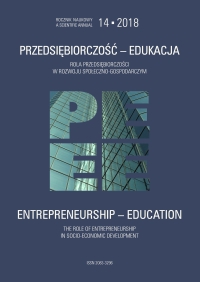Events as an Element Differentiating the Tourism Product of Cities. The Case of Pistoia (Italy)
DOI:
https://doi.org/10.24917/20833296.14.20Keywords:
authenticity, cultural tourism, events tourism, urban tourismAbstract
The dynamic development of tourism in many regions of the world causes competition boost which, in turn, leads to a variety of changes in tourist offers. Tourism is an alternative for other types of economic activity, this relates to spatial units of diverse area, including cities. The tourist function can become the mechanism of local development for cities and the protection of the cultural and natural heritage. Festivals and public celebrations, together with a variety of other special events are increasingly seen as unique tourist attractions and as destination image makers. The main goal of the article is to present the tourist potential of a historical city and the possibilities of further development of tourist movement in light of the current tendencies of the world tourist market. The paper also includes an attempt to analyse the structure of a tourist product of the city of Pistoia basing on its location as a neighbour of such large tourist centers as Florence or Pisa.
References
Attanasia, I.G., et al. (2013). Cultural investment, local development and instantaneous social capital: A case study of a gathering festival in the South of Italy. The Journal of Socio-Economics. DOI: 10.1016/j.socec.2013.05.014
Briganti, D. (2004). Pistoia guida della citta. Pistoia: Edimond.
Cieślikowski, K., Kantyka, J. (2015). Wykorzystanie wielkich wydarzeń w promocji miasta – na przykładzie Katowic. Zeszyty Naukowe Uczelni Vistula 40, 29–41.
Costa, P., van der Borg, J. (1992). The Management of Tourism in Cities of Art. Vrije Tijd en Samenleving, 10(2/3), 45–57.
Cuccia, T., Rizzo, I. (2010). Tourism seasonality in cultural destinations: Empirical evidence from Sicily. Tourism Management, 32, 589–595.
D’Afflitto, Ch., Falletti, F. (1999). Pistoia e il suo territorio. Calenzano: Mondadori.
Florek, M. (2006). Podstawy marketingu terytorialnego. Poznań: Wydawnictwo Akademii Ekonomicznej.
Getz, D. (1997). Event management & event tourism. New York: Cognizant Communication Corp.
Jędrusik, M., Makowsk, J., Plit, F. (2010). Geografia turystyczna świata. Nowe trendy. Regiony turystyczne. Warszawa: Wydawnictwo Uniwersytetu Warszawskiego.
Lew, A.A. (2008). Long tail tourism: New geographies for marketing niche tourism products. Journal of Travel & Tourism Marketing, 25(3–4), 409–419.
Marczak, M. (2015). Eventy jako produkty turystyki kulturowej na przykładzie miasta Kołobrzeg. Zeszyty Naukowe Wydziału Nauk Ekonomicznych, 19, 103–120.
Mariotti, I., Romei, P. (2009). Turismo a Pistoia. Pistoia: Comune di Pistoia.
Massidda, C., Etzo, I. (2012). The determinants of Italian domestic tourism: A panel data analysis. Tourism Management, 33, 603–610.
Melani, V. (2005). Pistoia. Pistoia: Tellini.
Ruozi, R. (2009). Pistoia e provincia. Pistoia: Touring Club Italiano.
Russoa, A.P., van der Borg, J. (2002). Planning considerations for cultural tourism: a case study of four European cities. Tourism Management, 23, 631–637.
Teobaldi, M., Capineri, C. (2014). Experiential tourism and city attractiveness in Tuscany. Rivista Geografica Italiana, 121(3), 259–274.
Tigri, G. (1990). Pistoia e il suo territorio. Bologna: Atesa.
van der Borg, J., Costa, P., Gotti, G. (1996). Tourism in European Heritage cities. Annals of Tourism Research, 23(2), 306–321.
von Rohrscheidt, A.M. (2010). Turystyka kulturowa: fenomen, potencjał, perspektywy. Poznań: Wydawnictwo KulTour.pl.
Zdon-Korzeniowska, M. (2011). Marketing terytorialny jako forma działań przedsiębiorczych samorządów terytorialnych w Polsce. Przedsiębiorczość – Edukacja, 7, 188–196.
Zduniak, A. (2017). Event jako ponowoczesna forma uczestnictwa w życiu społecznym. Roczniki Nauk Społecznych, 38(1), 207–234.
Downloads
Published
How to Cite
Issue
Section
License
Articles are published under the terms of the Creative Commons License (CC BY-ND 4.0; Attribution– NoDerivs).

